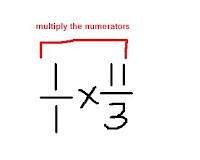in subtracting fractions, steps must be memorized and strategies must be used in different kinds of fractions. different kinds of fractions can be mixed number minus mixed number, mixed number minus proper fraction, even with different denominators, proper fractions with the same denominators, proper fractions with different denominators.*
*the denominators depend on the complication or ugliness of the two numbers. so different strategy can be used or shortcuts can be used in the ugliness of the denominators.
some examples or equations with different varieties will be shown here with explanations
1. subtracting proper numbers (answer can be simplified)
*common denominator

in this picture, the equation have the same denominators and the minuend is larger than the subtrahend meaning that the numerator in the first fraction is higher than the second one.

now, the answered is shown, the answer is right but the answer can be simplified. but how? the next illustration will show it.

to simplify the unsimplified answer such as 2/4, we need to get the factors of the numerator and the denominator, circle the same two factors that each number have (like shown in the picture). align the same factors, not in different factors to be organized and easy to understand (as shown in the picture). but...

if there are more factors that are the same, circle them, align them then multiply the common factors(shown in the picture) to get the GCF...if the numbers are too big and hard to identify, try to use prime factorization...it is used to find the prime factors of a big number

now we have the simplified answer...

so the solution of this equation looks like this
*clock method

i didn't draw a clock but this shows the minutes in each fraction.
*money method $

this shows the value in each fraction using money as a strategy
note: you will know that the answer is simplified if the factors of two numbers of the answer, the numerator and the denominator are prime or composite with prime. every prime number has a factor of 1 and the number itself so 1 is useless in finding the prime factors of a number because 1 is a prime nor composite number (1 x 1, 1 x 2,
1 x 3, 1 x ...)
2. subtraction of mixed number and proper fraction or a mixed number (the same denominator)
*money

 the solution is shown here using money
the solution is shown here using money
*clock
 the solutions shown in this post is clearly shown and what i did here is clock method
the solutions shown in this post is clearly shown and what i did here is clock method
3. subtraction of mixed number and proper fraction or a mixed number (different denominator)
*least common denominator (LCD)
 common denominator must be use when solving an equation with different denominators so in getting the common denominator of the two denominators, you can multiply them together, in prime numbers or prime numbers with composite numbers, you must do this method. but for more ease, the picture will be showed next...
common denominator must be use when solving an equation with different denominators so in getting the common denominator of the two denominators, you can multiply them together, in prime numbers or prime numbers with composite numbers, you must do this method. but for more ease, the picture will be showed next...

this picture showed how to get the LCD of the two denominators.

the lcd we found is 20 so i changed the fraction with the same denominators. and the pictures shows the similar changed of the numerators and the denominators.

the solution looks like this
note: if the numerator of the minuend, is smaller than the subtrahend,

borrow a whole and add it to the numerator, the whole must be shown as a fraction (1= a whole=??/??) the numerator and the denominator must be the same because it represents a whole number and the number must be the same as the common denominator of the equation

so the answer would be

i did this post so complicated...maybe hard to understand...just try to comment and understand...i hope you do...
 to answer this problem, one strategy can be used in solving this problem. it is ratio table. the picture shows how this problem will be solved. but the answer is not yet shown, it only showed how to get the whole room (1/4 x 4). to make 1/4 into a whole number which is one, the numerator and the denominator must be the same so since it was 1/4, we multiply it into 4 to get 4/4 or 1....one thing in ratio table is that when you do it in one side, do it on the other side. so we multiply the number 4 too, to answer the question.
to answer this problem, one strategy can be used in solving this problem. it is ratio table. the picture shows how this problem will be solved. but the answer is not yet shown, it only showed how to get the whole room (1/4 x 4). to make 1/4 into a whole number which is one, the numerator and the denominator must be the same so since it was 1/4, we multiply it into 4 to get 4/4 or 1....one thing in ratio table is that when you do it in one side, do it on the other side. so we multiply the number 4 too, to answer the question. this is to show how you multiply the fraction to 4... and 2 2/3 is the answer to this problem that can paint the whole room
this is to show how you multiply the fraction to 4... and 2 2/3 is the answer to this problem that can paint the whole room this shows the answer..,.its done...the answer is
this shows the answer..,.its done...the answer is


























































